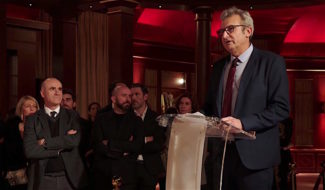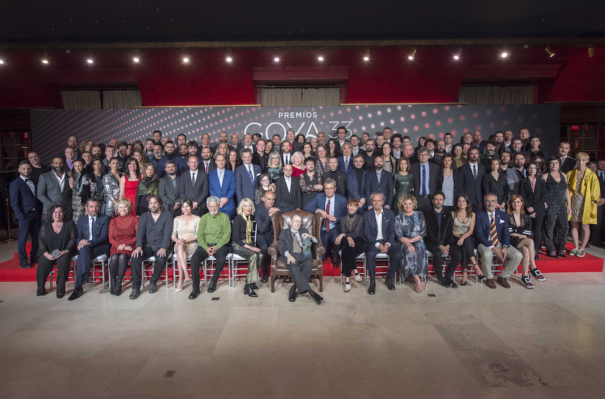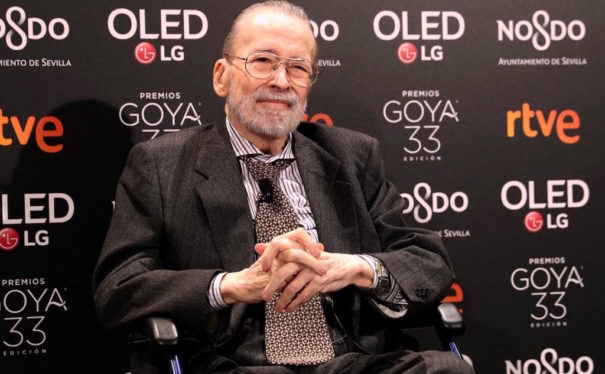Homenaje al gran maestro Chicho Ibáñez Serrador, Goya de Honor 2019, en la fiesta de nominados
La Academia de Cine celebra en el Teatro Real de Madrid la tradicional fiesta de nominados en la que el veterano director Narciso ‘Chicho’ Ibáñez Serrador ha recibido el Goya de Honor.
He Teatro Real de Madrid ha sido este lunes el escenario escogido por la Academia de Cine para la ya tradicional fiesta de nominados en la que los profesionales que optan a un Goya comparten impresiones y “calientan motores” para la gala de entrega que tendrá lugar el próximo 2 de febrero en Sevilla.
Las películas mejor situadas en la carrera para los Premios Goya, en un año en el que por quinta vez consecutiva el cine español ha superado los cien millones de recaudación, son: El reino (13 nominaciones), Campeones (11), Carmen y Lola y Todos lo saben (8), Quién te cantará (7), La sombra de la ley (6) y El hombre que mató a Don Quijote y Yuli (5).
El acto ha contado con la presencia de la mayor parte de los nominados, que estuvieron acompañados por Mariano Barroso, y Rafael Portela, presidente y vicepresidente primero de la institución, respectivamente.
 Barroso abrió el acto agradeciendo “a los 168 nominados y nominadas las ganas, el esfuerzo, la ilusión con la que desempeñáis vuestro oficio y la dignidad con la que nos representáis a todos”.
Barroso abrió el acto agradeciendo “a los 168 nominados y nominadas las ganas, el esfuerzo, la ilusión con la que desempeñáis vuestro oficio y la dignidad con la que nos representáis a todos”.
El momento álgido en esta fiesta de nominados ha sido la entrega del Goya del Honor 2019 a Chicho Ibáñez Serrador, el cineasta, realizador, guionista, director teatral y actor que contribuyó a popularizar el cine de terror y fantástico en España.
Javier Fesser, que encabeza las quinielas para llevarse el Goya a mejor director y mejor película por Campeones, aseguró que “para los que no fueron a una Escuela de Cine, Chicho era el mejor maestro”.
Barroso, quién calificó a Ibáñez Serrador como maestro de generaciones de cineastas, destacó que “aunque Chicho dirigió solo dos películas, son la punta del iceberg de todo su legado en la ficción española.
A partir de estas películas se han formado varias generaciones de cineastas y a muchos de nosotros nos has descubierto géneros y lenguajes que seguimos usando y reivindicando a día de hoy”.
“Nos ha enseñado el poder del silencio, y del alarido también, de la expectación y del susto.. pero también del entretenimiento como una forma elevada de creación”, señaló.
En tono irónico, Barroso añadió: “todavía hoy nos preguntamos quién puede matar mejor que Chicho”.
Por su parte, el veterano director recordó cómo en los inicios de la entrega de los Premios Goya le llamaron desde la Academia de Cine para que aportara ideas para la creación de la estauilla. Sin embargo, cuando le mostraron el primer “prototipo” quedó horrorizado al ver un bronce de Goya en el que en la parte trasera un botón activaba un abanico emergente que salía desde la cabeza del genial pintor acompañado de una musiquilla.
“Yo me quedé mirando aquel Goya, me fui… y no volví. Quizás por eso, esta sea, y lo agradezco, la primera noche que vuelvo a este hogar de profesionales”, reconoció.
Chicho, el hombre que asustó, divirtió e hizo pensar al público
Narciso Ibáñez Serrador (1935, Montevideo, Uruguay) es el hijo único de la pareja de actores Narciso Ibáñez Menta y Pepita Serrador. Criado entre giras y escenarios, debido a una enfermedad que padeció de niño se convirtió en un ávido lector y desarrolló su vocación intelectual.
En la década de los cincuenta, ya en España, trabaja como actor en la compañía de teatro de su madre y, poco después, pasa a la dirección teatral. En 1957 regresa a Argentina y, junto a su padre, inicia una exitosa colaboración en teatro, radio y televisión. Ibáñez Serrador se convirtió en un reputado profesional como actor, realizador y guionista en la televisión argentina, firmando muchas veces sus textos con el seudónimo Luis Peñafiel.
Siendo el teatro sus orígenes, –”mi escuela, mi universidad, mis antepasados”, en sus propias palabras– descubrió que la dirección y la escritura le atraían más que la actuación, convirtiéndose en lo que él denominó “autor que dirige” o “autor que realiza”.
Llegó en 1963 a España, con cintas de sus trabajos en Argentina que presentó en Televisión Española, a la que trasladó todo lo que había aprendido en América, revolucionando y modernizando la televisión de los sesenta en nuestro país con series como Mañana puede ser verdad o La historia de Saint Michel, pero especialmente con Historias para no dormir (1966). A estas se suman los títulos para la pequeña pantalla El último reloj, El asfalto, Historias de la frivolidad y El televisor (1974). Especializado en adaptaciones literarias y biografías de personajes célebres, sobre todo en su etapa argentina, fueron sin embargo sus historias de ciencia ficción y de terror las que más impactaron al público.
Este género también lo cultivó en el cine, alumbrando emblemáticos títulos del fantástico y el terror español: La residencia (1969) y ¿Quién puede matar a un niño? (1976), de las que fue guionista y director.
Su sello de identidad también incluyó el humor, con las presentaciones previas que hacía en Historias para no dormir o en los ciclos de Mis terrores favoritos, a los que aportó un toque de ironía y comedia. En la carrera de este divulgador de los clásicos del género, también figuran novelas radiofónicas y las obras teatrales Aprobado en castidad, El agujerito y El águila y la niebla.
Fundó la productora Prointel en 1970 para desarrollar sus propias producciones en cine, televisión, teatro y publicidad, entre las que se encuentran el mítico programa Un dos, tres, responda otra vez.
La trayectoria del hombre “tímido” que asustó, divirtió e hizo pensar al público fue reconocida con el Premio Nacional de Televisión en 2010, el Premio Maestro del Fantástico del Festival Nocturna, el Premio Ondas al Mejor Programa por Hablemos de sexo, premios Antena de Oro, Premio Iris y Premio Feroz de Honor, entre otros galardones, a los que ahora se suma el Goya de Honor 2019.
https://www.youtube.com/watch?v=4ookB0PgYSs
Did you like this article?
Subscribe to our NEWSLETTER and you won't miss anything.




